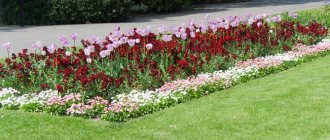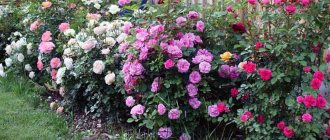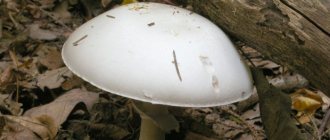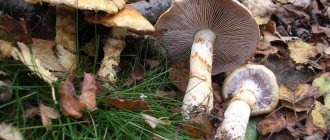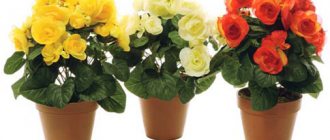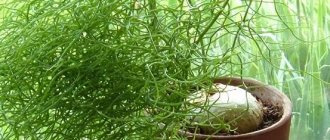Tuberous flowers
Tubers are shortened, modified underground shoots that acquire a conditionally spherical shape as a result of the growth of internodes.
Tubers are usually formed at the ends of the lateral shoots of the rhizome - stolons. The tubers of some plants are edible, such as Jerusalem artichoke or potatoes. Among the tuberous plants, the majority are herbaceous perennials, the ground part of which completely dies at the end of the season, but emerges from the growing point in the spring. During the season, the plant forms many tubers, so these crops have no problems with vegetative propagation. In cool climates, tubers overwintering in the ground need to be well covered, but if the winters in your area are really harsh, then it is better to dig up the underground part of the plant for the winter.
Among the decorative tuberous crops, gloriosa, sinningia, tuberose, caladium, smithiana, herbaceous peony, canna, anemone, begonia, diplodenia, delphinium, gesneria, dahlia, cyclamen, freesia and arrowroot are widely popular.
Tuberous plants do not tolerate acidic and too dense soils and require balanced watering. Before planting tubers, the area is fertilized with organic matter, and sand is placed in each hole for drainage.
Comparative characteristics of root modifications
Root vegetables and root tubers provide plants with the necessary nutrition during unfavorable periods. Such modifications of roots (the table shows examples of plants) are formed exclusively in bi- and perennial species. In the first year of development, only vegetative organs are formed from their seeds. In autumn, the stem and leaves die off, and the underground part overwinters thanks to the supply of water and substances. The following year, such plants bear fruit and form seeds. Modifications of the roots help them survive the cold winter.
The difference in root systems and growing conditions provides a variety of metamorphoses. Thus, respiratory roots are formed in plants that grow in waterlogged soils. Since their oxygen content is limited, adventitious roots absorb this gas directly from the air. This makes the breathing process possible.
The plant can grow only under conditions of intense photosynthesis. Sometimes this requires placement even on completely vertical surfaces. For example, ivy can even grow on the walls of houses.
Anemones - planting and care in the garden
Author: Marina Chaika February 27, 2021 Garden plants
It doesn’t matter how your love for anemones began - from a gifted bouquet or admiring a neighbor’s flowerbed - this flower knows how to make you fall in love with it at first sight!
So that your passion for this bright beauty does not turn into a dreary burden, be sure to familiarize yourself with the requirements of this flower sissy for care, watering, soil, lighting and delicacies... Are you hungry yet? Then catch the first life hack on anemones: the capriciousness of this flower depends... on the variety! If you are not yet ready to pay a lot of attention to the flower you like, just choose a “more accommodating” anemone.
How not to get lost in the fascinating, but such a huge (today there are about 160 species!) assortment of anemones? How to choose an unpretentious or, on the contrary, the most “complex” anemone? How not to confuse the summer anemone with the autumn one, and even less fuss with the mandatory annual freezing of seeds - we’ll tell you right now.
Dahlias: growing from seeds and tubers
Author: Marina Chaika February 18, 2021 Garden plants
Did you know that 90% of your success in growing dahlias in full bloom depends on how you... store them?
In second place is the right soil. Gardeners look for signs of disease or pests, but the most common cause of death of first or transplanted dahlias is unsuitable soil. Yes, dahlias can heroically withstand changes in acidity, but good soil permeability is vital for this plant. If the site you have chosen cannot boast of such, this can be easily corrected. When digging the soil in the autumn, add a little ash, peat, humus, sand to the soil, and add chopped straw.
It will also be useful to spread straws in the spring, after planting the tubers. It will help retain precious moisture and save you from unnecessary work on loosening the soil.
Read more tips and secrets for growing your favorite dahlias in our article.
Corm garden flowers and their photos
The most famous corm garden flowers are crocuses and their varieties. Next you can look at the photo of corm flowers, which are easily grown and propagated in various conditions.
CROCUS, SAFFRON – CROCUS
- Flowering time: depends on the variety
- Location: sunny or slightly shady
- Reproduction: division in autumn
There are four groups of this bulbous plant.
Dutch hybrids with large flowers (bloom in spring), hybrids of golden-flowered crocus (C. chrysanthus) with medium flowers (bloom in spring), early-blooming species with small flowers (bloom in early spring) and autumn-blooming species with small flowers.
Irises: growing in open ground
Author: Marina Chaika February 27, 2021 Garden plants
Iris means “rainbow” in Greek. Today this rainbow has more than 700 shades and 35 thousand varieties! But it’s not just the colorful and delicate colors of the cockerels that captivated us: perfumers all over the world value irises for their unique bright aroma.
Did you know that bearded irises are more drought tolerant than their beardless counterparts? That the orris root popular among traditional healers, confectioners and perfumers is actually the root of irises?
We will tell you about these and other secrets of iris in our article.
Why do some irises have no scent? How to save iris from slugs without using chemicals? Do irises need to be covered for the winter? How to prune iris bushes correctly and beautifully after flowering? Why don’t cockerels want to bloom even on “ideal” soil and watering?
Callas - growing at home and in the garden
Author: Marina Chaika February 09, 2021 Garden plants
Calla plant (lat. Calla) , or Zantedeschia (lat. Zantedeschia) is a genus of perennial plants of the Araceae, or Aronicaceae family. The calla flower grows in damp places in South America and Africa, from Nigeria to Tanzania. It is a relative of such a plant as calla lily, or marsh calla, the only representative of its genus, whose range is located in the Northern Hemisphere. Zantedeschia is sometimes called Ethiopian calla lily, or Richardia. The flower received the name “zantedeschia” from the German botanist Kurt Sprengel, who named it in honor of his friend the Italian botanist Giovanni Zantedeschi, but most often zantedeschia is still simply called calla lily. The attractiveness of this plant for gardeners is not only in the very large, showy leaves and unusual flower shape, but also in the fact that calla lilies can be grown both in the garden and at home, in a pot.
Article on the topic: Euonymus plant family: list, description, genera and species
Garden and indoor tuberous plants: types and cultivation
- View the full image
Tuberous plants
Tuberous plants: description
Garden tuberous plants
Hemanthus
How to plant tubers
Care Tips
Possible problems during cultivation
Ornamental flowering plants are grown from the tubers, which die after flowering, leaving living baby tubers in the ground, which enter a dormant period during the winter and germinate when favorable conditions occur. They can be left in the ground, or they can be dug up and stored until the next planting. The tubers of some plants can be eaten, for example, potatoes and Jerusalem artichoke.
Features of growing bulbous plants
- • Most bulbous plants are planted in well-lit areas with light, lush, water- and breathable soils, rich in neutral nutrients.
- • Spring bulbs (blooming in spring) are planted in open ground mainly in September-October, summer bulbs (which do not overwinter in our conditions) - in April-May.
- • The planting depth should be equal to three times the height of the planting material. Typically, the distance between large bulbs in a row is 10-15 cm; small bulbs and “children” are planted more densely.
- • Most bulbs are winter-hardy, but daffodils and hyacinths can freeze in snowless winters, so they should be covered with mulch (peat, straw, pine needles or fallen leaves) during the winter. This is done in November, when the temperature is below zero and the ground freezes a little. Mulching material is removed in the spring, when the threat of spring frosts has passed.
- • After plants bloom, flowers need to be removed - they “steal” the nutrients necessary for the development of the bulbs.
- • Most spring bulbs cannot be left without replanting for 4-5 or more years. Nests are usually dug and divided in June after the leaves have dried.
- • Summer bulbs are dug up in October, dried for 2-3 weeks, then they are cleared of the soil, the “babies” are separated and stored until planting.
Tuberous plants: description
Tubers are short shoots of plants with axillary buds that have a rounded shape. They develop at the ends of elongated shoots of the rhizome. The tubers store a large amount of nutrients that plants use to feed themselves during winter or drought to extract the energy needed to restore growth the following season.
Tubers come in stem and root varieties and are used for plant propagation:
- Stem tubers usually form on the subcotyledonous knee, which is located below the cotyledonary node. Often, such tubers have one or two epicotyledonous knees - plant parts of seedlings between cotyledons with developed leaves. Stem tubers have a vertical direction of germination and an ovoid shape. At the narrowed end there are several vegetative buds.
- Root tubers form on the sides of the parent plant and are located shallow underground. Many such tubers live as long as the plant grows and develops, after which they die. But the tubers of some plants, for example, begonias, can live long and give life to several generations of plants.
The variety of tuberous plants allows gardeners to grow them both in the garden and at home.
Modifications of roots: table
The types of metamorphosis of the underground organ differ in annual and perennial plants and depend on the place of growth, climate characteristics, and location in relation to the support. The structure and functions of root modifications are presented in the table.
| Root modification | Structural features | Function | Example |
| Roots | Thickening of the main root and lower parts of the stem | Supply of water and organic nutrients | Carrots, beet, rutabaga |
| Root tubers | Thickening of lateral and adventitious roots | Storage, vegetative propagation | Dahlia, chistyak, yam (sweet potato) |
| Trailer roots | Modification of adventitious roots | Attaching to a support | Ivy |
| Respiratory (air) | Lateral roots that grow upward and rise above the surface of the soil or water | Absorption of water from air | Orchid |
| Supporting | Adventitious roots that develop on the visible part of the stem | Keep the plant upright | Corn, ficus banyan |
| Sucker roots | Adventitious roots that can penetrate the stems of other species | They lead a parasitic lifestyle, feeding on the juices of their “neighbors” | Dodder |
Garden tuberous plants
Grow garden tuberous plants:
- Anemone (Anemone) begins to bloom in March-April, loves well-lit sunny or slightly shaded places, the division of baby tubers is carried out in the summer. Tuberous anemones are represented by chamomile-shaped and poppy-shaped forms. The former have flowers with yellow centers and narrowed petals. The most common is the tender anemone, which grows up to 15 cm. The flowers of the latter are similar to poppies and can be double or single. The most popular poppy anemone is the crowned one, the height of which reaches 30 cm.
- Begonia requires annual replanting and renewal of depleted soil, which is carried out in the spring. At the time of planting, it is very important that the tubers of the plant have already sprouted a little. Begonia tubers are not annual; they are capable of giving life to the plant for several years. Typically, begonias bloom two months after transplanting or planting. The older the plant, the faster it will bloom. Every year the plant lays buds lower and lower. Begonia blooms in June and prefers slightly shaded places and abundant watering, especially in dry weather. Sprouted tubers are used for propagation. Particularly popular are multi-flowered begonias (20 cm high) and drooping begonias (up to 60 cm). These plants grow equally successfully in home and garden conditions.
- Dahlias require special attention when storing tubers. After the above-ground part dies, the stems are cut off so that the root collar is preserved. The tubers are dug up, the soil is washed off, the thin roots are removed and dried. After this, they are stored. In winter, tubers need to be inspected, rotten and spoiled specimens must be removed. Successful storage of dahlia tubers depends on the time of digging, which is best done after frost.
- Crocosmia (Crokosmia) can decorate any flower garden thanks to its bright sunny and crimson colors. Flowering occurs in July-August, prefers sunny, well-lit places. These perennial tuberous flowers have sword-shaped leaves and orange-yellow funnel-shaped flowers. The plant grows up to 60 cm and annually produces several small baby tubers. When growing, annual replanting is not required, but they prefer well-lit areas without drafts and require shelter for the winter. The best time for reproduction is spring. Reproduction by seeds is possible, but flowering occurs after two years.
- Corydalis (Corydalis) is a perennial plant of the smoke family. Typically, the plant is not tall, reaching a height of 10-30 cm. Corydalis has bluish-green leaves that die off by the end of spring. The flowers are collected in racemose peduncles at the tops of the stems. Flowering occurs on the eve or after the leaves die off in May - June. After flowering, they form fruits, thanks to which they can reproduce by self-sowing. Corydalis prefers shaded places.
Plants for the garden
Garden tuberous plants are represented by a wide variety and species diversity. This group includes primroses, crops with a medium and late growing season. They are resilient, but require special attention when growing and caring for them.
Anemone
Among flower growers, this plant is better known as “anemone”, since the petals begin to flutter even with minimal exposure to wind. This is a low-growing herbaceous shrub of the Ranunculaceae family. Forms a powerful rhizome with cylindrical tubers. The height of the stem varies from 30 to 70 cm. The leaves are formed on long petioles and have a dissected shape.
Flowers can be single or collected in umbellate inflorescences. Depending on the variety, the petals are white, purple or pink. The formation of flowers begins in early spring and lasts up to 2 months, then they form a hazel-shaped fruit with a characteristic pubescent surface.
Dahlia
A multi-species genus of flowering plants in the Asteraceae family. It is actively used in gardening, often used in landscape design for planting as a tapeworm, in group compositions. It is distinguished by the large size of its flowers and the variety of colors and textures of its petals.
Depending on the variety, the stem can grow to a height of up to 2.5 m. It forms powerful and fleshy tubers that tolerate division well. Dahlias begin to bloom in mid-summer and remain decorative until the end of the season. The plant is grown as a perennial crop; replanting to a new location is required every 5-8 years.
Gladiolus (Skewer)
A perennial of the Iris family, most species grow in Africa. The root system is represented by a round corm, which is actively growing and developing. Depending on the varietal group, the height of the stem varies from 50 to 150 cm. The leaves are very thin and have a characteristic sword-shaped shape.
Gladioli gained their popularity thanks to their decorative flowers. It is collected in a long spike-shaped inflorescence, growing up to 80 cm in height. The buds are funnel-shaped, the petals have a simple or terry texture. Interesting varieties of swords:
- Lace swirl;
- Moon trail;
- Magic of color;
- Oscar;
- First grader.
Gladiolus has high vitality and quickly adapts to the climate and soil composition. Some gardeners dig up tubers after flowering to store them indoors, which reduces the risk of plant death.
Crocosmia (Montbrecia)
Decorative flowering crop for growing in the garden. The plant has been actively used in landscape design since the late 19th century; in some regions it is called “Japanese gladiolus.” Forms a powerful bush up to 100 cm high. The root system is represented by large corms in the shape of a cluster. The leaves are collected in a basal rosette, have a sword-shaped shape, and often their surface is corrugated. Paniculate inflorescences develop in mid-summer and remain attractive until September.
Each flower is shaped like a five-pointed star; the petals can be curved back. Depending on the variety, their diameter varies from 2 to 5 cm, the buds are usually colored red, yellow or orange. Crocosmia looks best as part of a group planting or in a mixborder in the background. It does not tolerate darkening and increased acidity of the soil, which is important to consider when choosing a location for a flower bed.
Indoor tuberous plants
The most popular indoor tuberous plants:
- Ginger (Zingiber) produces cone-shaped flowers that are collected in long inflorescences. It is easy to care for and blooms annually. In addition, its tubers are edible and have healing properties. Ginger prefers warm, bright places and regular watering. In autumn it goes into retirement, signaling this by yellowing leaves. The plant is propagated in early spring by dividing the tubers.
- Pleione belongs to the orchid family. Forms from five to eight peduncles of delicate shades - from whitish and yellowish to pink and lilac. Flowering of different species occurs in spring and summer. Green tubers indicate flowering in the spring, while reddish tubers indicate flowering in the summer. The plant rests from autumn to spring. The life span of tubers is no more than two years. Pleiones grow well in slightly acidic clay-peat soils, which should be constantly moist. However, during the dormant period, watering is stopped.
- Hemanthus (Haemanthus) from the amaryllis family. The name of the flower translates as “flower of blood.” However, it is popularly called “mother-in-law’s tongue” because of its elongated, fleshy leaves. The most beautiful species are considered to be hemanthuses with blood-red and white flowers. Beautiful large spherical flowers appear earlier than the leaves - in April-May. But for this, the flower must be kept in dry soil at a temperature of 10 degrees for two months (from October to November). The plant should be propagated and replanted at the end of winter. Watering is needed moderately, and after the formation of leaves - abundant. During the development period, hemanthus needs to be fed with liquid fertilizers once a week.
Related article: List of plants starting with the letter K: indoor, garden and vegetable gardens
Modified roots
Due to the change in functions, the root system also changes its structure. This is fixed in the genotype of the plant and is passed on from generation to generation. The modified roots associated with the work they perform are very different.
- Trailer roots . If for some reason a shoot needs to rise up using support, it turns its adventitious roots into hitches. Many vines, such as ivy, have such modified roots.
Ivy roots
- Sucker roots develop in obligate and facultative parasitic plants. With their help, the dodder penetrates the body of the host plant and receives nutrients from it.
Dodder
- Mycorrhiza (fungal root) is a close symbiosis of the root and fungal hyphae. Due to this cohabitation, plants increase their absorption surface and the amount of water, minerals and organic substances they receive. The mushroom receives sugar and other useful components from the plant. Symbiosis does not exclude the possibility that at certain stages of life a fungus can simply parasitize a plant, and plants often “digest” the hyphae of fungi. Therefore, mycorrhiza can be considered as a unique type of parasitism.
Hyphae penetrate the root through root hairs, grow along the intercellular spaces and are fixed in the cortex in the root absorption zone. If the hyphae form a sheath located outside the root, then they speak of ectomycorrhiza . This type is typical for shrubs and trees. Ectomycorrhiza is capable of replacing roots with root hairs, which often do not develop at all. If all the hyphae are located inside the root, then the mycorrhiza is called endomycorrhiza (onions, cereals, walnuts, grapes). Most modern grasses and trees form mycorrhizae, and orchids, heathers and wintergreens generally cannot live without symbiosis with fungi.
- Bacterial nodules on legume roots are modified lateral roots, an adaptation to symbiosis with bacteria from the genus Rhizobium. These microorganisms penetrate into young roots through root hairs and cause the formation of nodules. Bacteria are found in the cytoplasm of bacteroid tissue cells. The outside of the nodule is covered with periderm; between it and the bacteroid tissue there are vascular bundles connected to the vascular system of the mother root. There is a close biochemical interaction between root cells and bacteria. Bacteria fix nitrogen from the air in soil wells and share it with the plant. They themselves obtain organic substances from them. This is a very important symbiosis for us. Thanks to it, legumes are very rich in proteins due to the large amount of nitrogen available to them. In addition to legumes, other plants are capable of forming symbiosis with nitrogen-fixing bacteria, such as oleaster, alder, sea buckthorn, podocarpus, etc.
Bacterial nodules on clover roots
- Stilt roots ( buttress roots ) are formed in mangrove trees. In rhizophora (Rhizophora), powerful adventitious modified roots extend from the trunk, which, upon reaching the ground, branch and grow into it. Thanks to stilted roots, trees acquire a large support area and are held on unstable muddy ground even during low tides. Plants with weak stems that live in other natural complexes, for example, forms of Indian banyan trees, also have the same roots.
Stilted roots of mangrove inhabitants
Banyan tree roots
- Disc-shaped modified roots are characteristic of large trees growing in tropical rain forests. They develop at the base of the trunk and provide them with additional support.
Disc-shaped roots
- Aerial roots . These modified roots are formed in many tropical epiphytes, for example, orchids and bromeliads. Epiphytes use trees to climb towards the light. The aerial roots of orchids hang freely in the air; they are adapted to absorb moisture that falls on them in the form of dew or rain. A special covering tissue, velamen, is formed on the surface of aerial roots. It is similar to rhizoderm, but differs in its multilayered nature and the fact that its cells die off. Therefore, velamen absorbs water not by osmosis, but by capillary.
Aerial roots of fig tree
Epiphytic plant bromeliad
- Respiratory roots (pneumatophores) are developed from underground lateral roots in tropical mangrove trees, inhabitants of marshy ocean coasts, in the ebb and flow zones. In Avicennia, the respiratory roots grow vertically upward. At their ends in the periderm there are many lenticels associated with aerenchyma (air-bearing tissue). Through these tissues, air enters the underground organs of the plant.
- Retracting roots (contractile) . These are lateral or adventitious roots that can shorten at the base, which leads to the retraction of the shoot to a depth. They can be recognized by their transverse thickening with wrinkles. Retracting roots help the shoot (bulb, rhizome, corm, etc.) find a comfortable position in the soil. Where climatic conditions require surviving a harsh winter, they help perennial plants to hide in depth and allow their regeneration buds to survive the harsh conditions. In some plants with shortened stems, retracting roots ensure that the rosettes adhere tightly to the ground (dandelion, plantain). Scilla, saffron, onions, and terrestrial orchids have contractile roots.
- Storage roots are often very thickened and rich in parenchyma cells. The storage main tissue is located in the core, primary bark and wood of the modified root. The thickened lateral or adventitious roots of Lyubka, dahlia, sweet potato, and chistyak are called root cones , or root tubers . In biennials in the first year of life, less often in other taproot plants, a formation called root crop . By storing substances, it helps the plant survive the dormant period and complete development at the right time. The formation of a root crop involves the main root and the transitional tissue between the stem and root (hypocotel). In carrots, almost the entire root crop, with the exception of the top part, is made up of the root. In turnips, the root forms only the lowest part of the root crop, and its main part is formed by the hypocotel. Even different varieties of radishes are characterized by different degrees of participation of the stem and hypocotel in the formation of the root crop. Root crops and root tubers form adventitious buds and serve for vegetative propagation. Juicy and large root crops of cultivated plants appeared as a result of long-term artificial selection.
- Root shoots are formed from adventitious buds that appear on the roots of many dicotyledons. They develop into an above-ground shoot and are also called root shoots. Typically, such modified roots are found in perennial plants such as cherry, raspberry, lilac, aspen, poplar, etc. Root suckers serve for vegetative propagation. Plants grown from the shoots of one individual are called clones.
How to plant tubers
Before planting tuberous plants, you should study their characteristics. Some species need to be planted in the fall, while others need to be planted in the spring. Spring plants are planted in the fall before frost. Before the onset of cold weather, the tubers should have time to take root, but not begin to grow. During frosts, plants enter a period of dormancy, and with the onset of spring they wake up.
Most tuberous plants can be left to overwinter in the ground, but those that bloom in summer do not tolerate frost and must be dug up and stored in a cool room. Such tubers are planted in the spring, when stable warm temperatures occur (begonia, anemone, dahlia).
When purchasing tubers, you should pay attention to their appearance - the tubers should not have spots that indicate infection with diseases.
The roots should be healthy and strong, and the tuber itself should be crowned with a small sprout, which shows that the plant is viable. Before planting tuber crops, planting material should be treated in a manganese solution for disinfection and protection from diseases and pests.
- The main thing to remember is that tuberous plants do not tolerate acidic soil; slightly alkaline soil is ideal for them. If the soil on the site is acidic, then lime or ash should be added when preparing it.
- Also, the soil should not be over-moistened. There should be no stagnation of water on the site after rains, otherwise the tubers will be affected by rot.
- The soil should be slightly diluted with sand to ensure moisture permeability and oxygen saturation.
- Fertilizers must be applied before planting, placing high-quality organic matter in the planting hole and be sure to sprinkle it with a small layer of sand, just like the tubers themselves, so that the soil does not stick to them and cause rotting.
- It is also necessary to ensure good drainage.
Care Tips
All types of tuberous plants are quite unpretentious in care. All they need is:
- Lighting and temperature. Most often, tuberous plants love abundant light, where they actively develop and bloom faster. Partial shade is also suitable for these flowers, but flowering occurs a little later. Lighting should be plentiful, but without exposure to direct sunlight, which can shorten the flowering period and worsen the decorative appearance of plants.
- A comfortable air temperature for normal plant development during the growing season is at least ten degrees Celsius. However, during the rest period the temperature should be close to zero, but not minus.
- Irrigation and air humidity. Proper watering is the key to active development and lush flowering of tuberous plants. Lack of moisture can cause flowers to fade in color and drop leaves and buds. In hot weather, it is recommended to water in the early morning, avoiding getting the foliage wet to prevent sunburn. You should also not overwater the plants - this can lead to rot and mold. To ensure the necessary moisture, plants should be sprayed in the morning and evening hours. In this case, the water should not be cold, otherwise there will be a sharp temperature drop, which will lead to the death of the plant.
- Application of fertilizers. It is forbidden to apply fresh manure, especially cow manure, directly under the tuber. To increase the resistance of plants and ensure their nutrition, young plants need to be fed with liquid complex fertilizers with a low nitrogen content. This will stimulate the growth and development of shoots and foliage, as well as accelerate the formation of buds.
Possible problems during cultivation
In order for tuberous plants to please with their appearance, they must be properly cared for. Improper care can lead to:
- gray rot and powdery mildew affect tuberous plants with excessive moisture
- with a lack of nutrients in the soil, plants become stretched and thin, and flowers lose color saturation
- if watering is excessive, the tubers are affected by mold, rot and fungal diseases
- with a lack of light, plants slow down and their leaves turn yellow
- When the air is dry, the leaves curl and dry out.
Tuberous plants have won the favor of gardeners due to their decorative properties and ease of care. Many species do not require annual replanting and add variety to the flower garden or decorate the windowsill. By adhering to simple rules, you can achieve unprecedented success, and the variety of species gives you the opportunity to choose and fantasize.
More information can be found in the video:
Significance in economy and nature
Many of the plant names from the root modification table are familiar to everyone. First of all, these are root vegetables. Humans use them as staple foods and seasonings. These are radishes, parsnips, beets, carrots, parsley, horseradish. Turnips and turnips are used as pet food. And sugar beets are a sought-after raw material for the food industry. Root tubers or cones have accessory buds. Therefore, with their help, vegetative propagation is carried out. These two types of modifications are classified as storage roots.
A special group of metamorphoses consists of haustoria or sucker roots. If their cells are completely devoid of chloroplasts, such plants are parasites. They exist at the expense of other species. One of the most striking examples of parasitic plants is Rafflesia, which has the largest flower. This species obtains nutrients exclusively from the numerous vines of tropical forests. But mistletoe, despite the fact that it feeds on the juices of its host, has not lost its ability to photosynthesize. Such species are called hemiparasites.
So, modifications of the root, the underground organ of plants, are formed to perform additional functions. Root vegetables and tubers (cones) store substances. Haustoria carry out parasitic nutrition of plants, and aerial ones carry out the process of respiration. Supporting and clinging roots provide the most favorable location of the shoot in relation to sunlight. This makes photosynthesis as intense as possible. We hope that now everyone will be able to fill out the table of root modifications.
Garden flowers perennials
Popular crops that can be found in almost all flower beds and gardens allow you to create a landscape design that will last for many years. In most cases, the most beautiful garden flowers, perennials, are easy to care for and resistant to low temperatures. There are plants that bloom in early spring, and there are those that will delight throughout the summer.
Early garden flowers perennials
If you want to enjoy flowers as the first warm days appear, plant bulbous plants such as snowdrops, crocuses, muscari or reticulated irises. In addition, there are other perennial early garden flowers:
- Hellebore.
It amazes with its variety of colors and early flowering. It is better to plant in spring, but in warm regions it can also be planted in autumn. The perennial flower is easy to care for and resistant to disease.
- Primrose.
Flowering can be observed already at the end of March, and it is abundant, and with proper care at the end of summer, the plant will delight you with the appearance of buds again. Can be grown in plots and in pots. They tolerate transplantation well.
- Periwinkle.
A perennial plant that retains green foliage even under snow, and flowers appear in April. They differ in color, and there are even terry specimens. They like moderately moist soil and shaded places.
Article on the topic: Powdery mildew disease - control and treatment, drug and remedy for powdery mildew
Unpretentious garden flowers perennials
Many people plant crops to decorate their garden that do not require excessive care. There are excellent perennial garden flowers that do not require care:
- Lupine.
This plant is popularly considered a weed, but it is also very beautiful. Soil and special care are not important for him. It is better to plant a flower on the sunny side. If you cut off the faded “candles”, flowering will occur again.
- Garden chamomile.
A perennial flower that will decorate any flower bed. It will delight you with flowering for a long time, and it lasts for a long time when cut. Watering and fertilizing are carried out in the usual ways, without special conditions.
- Phloxes.
There is a wide range of colors and even “chameleons” that change the light according to the lighting. These perennial garden flowers can grow for up to eight years without care, but when the flowers begin to get smaller, you should fertilize them with organic matter.
Long-blooming perennial garden flowers
When thinking about decorating a site, many gardeners prefer to choose crops that can bloom for a long time. To their delight, there are many such plants, and here are popular perennial garden flowers that bloom all summer:
- Pansies.
If you plant summer varieties, you will be able to see bright colorful flowers until late autumn. It is worth noting resistance to heat and ease of care.
- Astilbe. This perennial garden flower is beautiful not only during flowering, but also before and after it. An excellent option for a rock garden. Loves partial shade, but is not fussy about care. The colors are very varied.
- Dianthus grass.
It grows in creeping bushes that can cover a large area. The flowers are small red. Flowering occurs from July to September.
- Large-flowered flax.
Popular species with red flowers. Although they live for one day, they change to new buds and this continues all summer and until October. Flax is fastidious, grows in any soil and tolerates drought well.
Garden shade-loving perennial flowers
Some crops do not grow well in the shade, and there are those that only need such conditions. Among those that do not bloom, the ideal option is hosta. There are other garden perennial flowers for shady places:
- Dicentra.
One of the most beautiful and original flowers that are easy to care for. It is important to plant in well-drained soil. Interestingly, the more shade there is on the site, the longer the flowering will continue.
- Forest bell.
These perennial garden flowers are used for flower beds, edgings and for decorating areas under trees.
- Badan.
Perennial plants have beautiful pink flowers that can decorate the site. Interestingly, after the snow melts, the leaves of this crop are healing.
Garden perennial flowers vines
You can decorate your site and buildings with the help of beautiful vines, among which are such popular flowers.
- Climbing rose.
The plant boasts long flowering, and the buds bloom only once. These perennial garden liana flowers love the sun, and in winter it is recommended to wrap them up.
- Ivy.
An unpretentious crop that can be grown even in Siberia. Dense foliage creates good shade, for which the branches should be tied in the right direction.
- Honeysuckle.
Some species of these plants have flowers and original foliage. At night, the open buds emit a pleasant aroma. For good flowering, it is better to plant in sandy and loamy soils. It is recommended to cover in winter.
Perennial garden tuberous flowers
A popular group of plants that are highly decorative, but they will have to be looked after. Common tuberous garden flowers:
- Corydalis.
The most popular species is the crested hollow. The bushes grow from 10 to 30 cm, and it is better to place them in shady places with loose forest soil.
- Gladiolus.
These are corms, presented in 200 species. They are distinguished by an erect stem with inflorescences and spikelets. These garden flowers come in different colors and may differ in flowering time and flower size.
- Crocosmia.
The bushes reach a height of 50-60 cm, and they should be planted in sunny areas protected from the wind. The soil should be rich and well-drained. In winter it needs to be covered.
Perennial bulbous garden flowers
This group contains interesting and beautiful plants that will delight you with their beautiful flowering. In most cases they are early. The most popular bulbous garden flowers perennials:
- Snowdrop.
The culture loves sunny places, but it is not picky about the soil. Flowering is observed throughout the month, but the bulbs should be planted in the fall.
- Crocuses.
Another common name is saffron. These perennial garden flowers come in different colors: yellow, purple, white, lilac and so on. Planting is carried out in the fall, and flowering occurs, like snowdrops, in March.
- Hyacinths.
The plants are known for their large inflorescences, which can be of different colors, for example, white, pink, burgundy, blue and so on. It is better to plant in shaded and protected places from the wind. Hyacinth does not like excessive moisture.
- Common bulbous flowers that are perennials include muscari, daffodils, reticulated iris and scillas.
The most beautiful perennial garden flowers
It is impossible to definitively answer which crops are the most beautiful, since everyone has their own taste. Therefore, in addition to the options described above, you can also offer these most beautiful garden flowers:
- Rose.
According to reviews, this is the most beautiful plant, which is presented in a wide range of colors. By selecting different varieties, you can get a flowerbed that will bloom throughout the summer and half of the fall.
- Lily.
A flower that can become a decoration for a flower bed, thanks to its large and colorful buds. It does not require maintenance and is resistant to pests.
- Peony.
Bushes with large and fragrant buds will decorate the area. This crop does not require special care. Peonies are easy to propagate.
Sources:
https://floristics.info/ru/metki/klubnevye-tsvety.html https://megaogorod.com/atricle/2376-sadovye-i-komnatnye-klubnevye-rasteniya-vidy-i-vyrashchivanie https://fontan. fun/dacha/mnogoletnie-sadovye-cvety-luchshie-lia.html
Perennial bulbous flowers for the garden, garden, vegetable garden
If you ask novice gardeners what bulbous flowers they know for the garden, they will of course name: lilies, gladioli, hyacinths, crocuses, daffodils, tulips. These are the most famous examples of bulbous plants, people have been planting them in their gardens for a long time, they are loved and popular.
Hyacnite, tulip, narcissus
But the world of bulbous perennial crops is much larger. A large number of different species with small or huge flowers, fragrant and odorless, tall, there are also very small ones of various shapes, colors... Each type of bulbous flowers has many varieties with its own characteristics. Let's take a closer look at bulbous plants.
Small-bulbed primroses
This group of bulbous garden flowers has small bulbs, and they themselves grow no higher than 10-20 cm. But these spring bulbous flowers appear first in the garden. As soon as the snow melts and the sun warms the soil a little, primroses begin to wake up.
Primroses delight with their beauty when other plants are still dormant . On the bare ground, these babies are impossible not to notice. Blue, blue, white, yellow flowers are pleasing to the eye. And the very first to appear is the snowdrop.
Galanthus (snowdrop)
It is not for nothing that this delicate plant was given the name snowdrop . Appears in early spring, when there is still snow.
Snowdrop (galanthus)
it can withstand frosts down to -10°C without problems . Snowdrops grow and reproduce well in the wild without any care. This plant grows in clearings and blooms with snow-white flowers that look like bells. Small bells bow their heads down and look very touching. Unfortunately, they bloom very little, only 2 weeks. As soon as a green carpet of grass appears, they disappear.
Fact! Galanthus is listed in the Red Book; people really love to pick these flowers.
You can enjoy the beauty of snowdrops in forests and fields, but in the garden it is better to plant crocuses, similar to the Red Book primroses.
Spring crocus
Another representative of early bulbous flowers is crocus . This perennial grows from small bulbs in early spring.
Crocuses
No more than 20 cm in height, has thin elongated leaves, and goblet-shaped flowers. Crocus flowers come in different shades, there are even varieties with striped colors. In the middle of the flowers there are bright yellow or orange stamens. 1-3 peduncles appear from one bulb. Flowering is very short, within 10 days. But they are so pleasing with their bright buds, when there are no other flowers yet, that they definitely need to be planted in the garden. Planting in groups looks best.
Did you know? Crocuses overwinter well in the ground without shelter, are unpretentious, and after they bloom, they retain their green, tender foliage until June.
Among the crocus varieties there are autumn-flowering ones; they are planted in the garden in the spring.
Chionodoxa
Another harbinger of spring are the bulbous perennials Chionodoxa .
Chionodoxa
This plant is not very common, but in vain. This is an unpretentious primrose, has small open six-petalled flowers. They bloom with white, blue and pink flowers. On one peduncle there are whole inflorescences of delicate buds. The leaves are elongated and narrow. The height of the bushes is only 20 cm. During one growing season, the onion produces children, forming up to four onions.
Fact! Unpretentious chionodoxes grow in one place for up to 10 years.
Another advantage of the bulbous representative is that it grows well in both sun and shade.
Let's look at the rare garden sissy Pushkinia.
Pushkinia
Pushkinia belongs to the hyacinth genus, they are similar, and novice gardeners often confuse these plants.
Pushkinia
These perennial bulbous plants look spectacular in the garden. They are also grown at home. The height of the bush is 20 cm, the leaves are elongated, tapering towards the tips. The long, strong peduncle is covered with flowers. The six-petalled white flowers have a blue stripe in the middle of the petal.
Fact! Pushkinia does not reproduce as quickly as others: within 5 years they produce only 5-7 children.
During this period, the family is divided. However, it is able to reproduce by seeds, self-seeding. Thanks to this, Pushkinia exists perfectly in the wild on the slopes of the mountains of Eastern Transcaucasia and Iran.
Another beauty that covers the soil with a bright “carpet” is scylla or scilla.
Scylla (scilla)
Graceful and delicate woodland will undoubtedly decorate any garden.
Scylla (Scilla)
Scylla grows beautifully in meadows and fields, forming a blanket of blue flowers. Scilla is absolutely unpretentious and has unique vitality.
On a note! Plant Scylla in a sunny place in the garden, and it will delight you with its flowers every year.
The leaves look like hyacinths, but the flowers on thin long peduncles droop head down. Cultivated varieties have blue, white, and pink colors. There are varieties of scilla that bloom even in summer and autumn.
The following very beautiful plant is a rare guest in our gardens, but once you see it, you will definitely want to plant Erantis on your site.
Erantis (spring)
Erantis is the earliest, the very first, begins to grow even before the snow melts.
Erantis
Bright yellow buds on thin stalks, framed by green carved foliage, decorate the ground, like spring itself.
Fact! This herbaceous perennial plant grows well in wild conditions without any care.
And as a garden flower, it will wonderfully decorate flower beds. It doesn’t even require any care other than weeding and occasional feeding. Spring grass reproduces by self-sowing, forming nodules after three years.
The following plant with a bulb is known and grown by many gardeners. This is a bright and fragrant iris.
Iris reticulum (iridodictium)
Reticulated iris with bright flowers of various colors will wonderfully decorate your garden in early spring.
Iris reticulum
Irises are unpretentious, beautiful plants, but they have one drawback. In the summer, after the leaves begin to turn yellow, the bulbs are dug up, dried, and then stored until autumn in a dark, cool place.
All these delightful babies are the first to delight with their beauty in the spring, followed by other spring bulbous flowers.
Blooming in mid-spring
These types of perennial flowers decorate gardens in mid-spring. Their flowering is much longer than that of primroses, and the variety of varieties is countless. And the most popular symbol of spring and women's holiday known to every person is the tulip.
Tulip
The variety of types and varieties of tulips is amazing. Among the tall tulips there are the following types: double, fringed, goblet, lily-flowered, green-flowered, parrot-shaped, multi-flowered. And there are small tulips, these are Foster, Greig, Kaufman tulips.
Delicate tulips in the garden
Each type of tulip has a huge number of varieties. They differ in flowering time, plant height, and variety of bud colors. The colors of the buds include the entire palette of colors .
Tulips grow well in one place for many years, the main thing is that the place is dry, without flooding. After the tulips fade and the leaves turn yellow, cut off the above-ground part of the plant and plant annual flowers in this place. This way you will have a continuously blooming flower bed.
How to care for bulbs after flowering
Another bulbous flower that is often planted next to tulips is daffodils. They look great in the garden and have a long flowering period.
Narcissus
The daffodil does not have such an abundance of colors as the tulip, but this does not make it a less attractive plant.
Daffodils
Basically, these are white, yellow, orange and peach shades of inflorescences. The advantage of narcissus is that it grows well even in shaded areas. In addition, it has a pleasant aroma.
The following bulbous species are similar in size to primroses, but bloom in mid-spring.
Muscari (viper onion, mouse hyacinth)
Muscari is also called mouse onion. The bush and peduncle resemble hyacinth.
Muscari (viper onion, mouse hyacinth)
Small, goblet-shaped flowers are located on strong, plump peduncles. Muscari do not have a variety of colors, but they have a strong, pleasant aroma, it is unpretentious and blooms for a long time. Groups of different shades of blue or white flowers look cozy and delicate at the forefront of flower beds. Viper onions are easily propagated by children and also self-sow.
Novice gardeners have hardly heard of the rare bulbous erythronium, and you rarely see it in gardens.
Erythronium (kandyk)
If you want your garden guests to ask in surprise what kind of plant this is, plant kandyk .
Erythronium (kandyk)
This perennial herbaceous plant has broad leaves and delicate flowers on a long stalk. One peduncle grows from one bulb, on which, drooping, grows a delicate flower with petals turned outward. Delicate erythronium is completely unpretentious, reproduces by bulbs, and divides the family once every 4-5 years.
The real “highlight” of the site will be the fritillaria.
Hazel grouse (fritillaria)
The hazel grouse will definitely not go unnoticed in the garden, especially the royal hazel grouse .
Hazel grouse (fritillaria)
This perennial bulbous plant requires some care and obligatory digging in the summer after flowering, but with its attractive appearance it definitely deserves a place in the garden bed. The royal fritillary looks very majestic. On a strong peduncle up to 1 meter high there are large goblet-shaped flowers of orange, red or yellow. The bulbs of the royal hazel grouse are large and powerful.
Checkered hazel grouse
But there are other types of hazel grouse, for example, checkerboard hazel grouse. These are small plants, no higher than 35 cm, with drooping bells and small bulbs.
Everyone knows the next onion. This hyacinth, thanks to its fragrant smell, has become a favorite plant of many gardeners.
Oriental hyacinth
Hyacinth is often grown in pots. People can force the bulb at home without any problems and enjoy its aroma.
Oriental hyacinth
Not tall, with dense leaves, a thick peduncle, on which fragrant flowers seem to be tightly stuck. The bulbous hyacinth has few colors, but it is beautiful in any color. Looks good when planted alone or in groups.
There is no need to dig up hyacinth, because it is not capricious; it will only require standard care, unlike the next capricious anemone.
Anemone (anemone)
Anemones are not easy to grow in the garden. Anemone is demanding of light, moisture, and soil. But with some effort, you will get a wonderful plant in the garden.
Anemone (anemone)
On a note! It is tuberous anemones that require compliance with all growing rules, while rhizomatous anemones are unpretentious.
Anemone has beautiful carved leaves, bright multi-petaled open flowers with a dark center inside. Depending on the variety, they bloom in spring, summer or autumn. For the winter, anemones must be dug up and stored in the sand in a cool place.
The following types of bulbous flowers show their beauty in late spring.
Blooming in late spring
By planting different types of perennial flower bulbs, you can create a continuous bloom in your garden. Some plants will replace others. A variety of colors, shapes, and scents will delight you all season long. The following flower crops begin to bloom in May.
Allium (decorative onion)
Decorative onions look very original in the landscape; the huge caps of small flowers on a long peduncle are remarkable.
Allium (decorative onion)
The height of the peduncles in some varieties reaches 1.5 meters, and the inflorescences grow up to 25 cm in diameter. There are miniature varieties of allium, up to only 30 cm in height. In order for the onion flower to show all its beauty, it is necessary to plant it correctly. To do this, choose sunny places without stagnant water. For tall varieties, select areas protected from the wind.
Allium is gaining more and more popularity among flower lovers, unlike another plant whose name few people know.
Ornithogalum
Many species of poultry grow well in the wild in different countries.
Ornithogalum
Ornithogalum, depending on the variety, reaches a height of 30 cm to 85 cm. It has white simple flowers with yellow stamens in the middle. Growing poultry grass is not at all difficult, but it is important to choose the right type of plant. Some types of this culture are poisonous, while others are medicinal.
Another rare type of bulbous flower is camassia.
Camassia
Camassia is a little-known plant, only now designers have begun to use it in landscape design.
Camassia
Due to its unpretentiousness and versatility, camassia is used in almost any flower bed. It has long narrow leaves, different shades of blue flowers on a tall peduncle. Camassia varieties range in height from 20 cm to a meter. This bulbous perennial is perfect for creating a natural-style garden.
There are many summer-blooming bulbous perennials that deserve a prime spot in gardens.
Blooming in summer
There are not so many summer-blooming bulbous perennial flowers, but their variety is so wide that even from different varieties of the same plant species it is possible to create a gorgeous flower garden. For example, from beautiful lilies.
Lilies
These wonderful plants are loved by many gardeners for their beautiful large flowers.
Terry lilies
From the huge variety of varieties of this bulbous flower, even the most picky gardener has something to choose from. The lily has a huge number of colors , there are only blue and dark blue flowers. Almost all types of lilies overwinter well in the ground, except for the oriental ones.
Fact! Oriental lilies are the most fragrant, have huge flowers, but they are the most finicky.
There are many lily hybrids; this is a picky plant, but only plant it in a dry place, otherwise the bulbs may rot. This perennial overwinters in open ground, unlike the next flower crop, which dies even with the slightest frost.
Gladioli
gladioli in their summer cottages.
Gladioli
And if earlier there were few varieties, now there are no different colors. Gladioli are planted in the spring when stable heat sets in; gladioli bulbs do not tolerate even slight frosts. Depending on the variety and time of planting in the ground, they bloom from July to September.
Miniature gladioli are in great demand in Europe.
Glamini (miniature gladiolus)
Glaminis do not differ from ordinary gladioli in anything except size.
Glamini (miniature gladiolus)
They are no more than 50 cm in height, do not require a garter and look great in flowerpots. If you want to decorate your terrace or veranda with gladioli, plant glamini in flower pots and flowerpots. The bulbs must be dug up for the winter.
There is another plant called Japanese gladiolus, but it doesn’t look like a regular one at all.
Montbretia (crocosmia, Japanese gladiolus)
Crocosmia , unlike gladiolus, can withstand frosts down to -30 degrees in dry soil.
Montbretia (crocosmia, Japanese gladiolus)
Outwardly, it is radically different from gladiolus; it has long, sword-like leaves and tall peduncles on which are orange flowers with long stamens. Montbrecia's flower stalks are quite thin and require support. The advantage of crocosmia is its long flowering period from July to September. It looks especially wonderful in group plantings against the background of a lawn.
The next bulbous plant is also best planted in groups.
Galtonia (Cape hyacinth)
Galtonia , although it has a second name, Cape hyacinth, is not at all similar to it.
Galtonia (Cape hyacinth)
It has long leaves, tall drooping peduncles, from which small white bells hang. Galtonia is quite finicky, and also requires digging up the bulbs for the winter. In nature, galtonia grows in the Caspian Mountains, where it is humid, warm in the summer and dry in the winter. It is not always possible to create such conditions in the garden. But if you really want to plant this bulbous plant on your site, then choose an open place, preferably sunny, but it also tolerates shade.
Another rare plant, the white flower, loves shady places.
Summer white flower
Whiteflower belongs to the Amaryllis family. In nature, it grows in Turkey, the Mediterranean, Central Europe, and Iran.
Summer white flower
It should be planted in shady, moist places, ideally near bodies of water. Up to 40 cm in height, different types of whiteflower bloom from spring to late summer. By planting different species, you will achieve continuous flowering in the garden. The white flower winters well in the ground and is not afraid of frost. The bush is divided every 5-7 years, thus obtaining new plants.
Autumn bulbs will help continue the flowering parade in the garden.
Blooming in autumn
There are few perennial bulbous plants that bloom in autumn, but they deserve the attention of gardeners.
Colchicum (Colchicum, Autumn)
Colchicum looks interesting in the garden, its delicate flowers seem to stick out from the ground. Unfortunately, the flowering time is short, a maximum of 12 days .
Colchicum (Colchicum, Autumn)
Colchicum has spring-blooming and fall-blooming varieties. To obtain spring flowering, flower bulbs are planted in the ground in the fall; for fall flowering, they are planted in August. After just 1.5 months, flowers appear on the soil surface. The plant is quite winter-hardy and grows in one place for up to 7 years, but it is recommended to divide the family so that the bulbs do not become smaller. The autumn plant loves moist soils and shady places, and it looks great on alpine hills, like the next perennial.
Garden cyclamen (dreva, alpine violet)
Cyclamen is not exactly a bulbous plant, but rather a tuberous one. But it is perennial and overwinters in the garden.
Garden cyclamen (dreva, alpine violet)
Cyclamen is a very beautiful plant, and it blooms , up to three months . Cyclamen grows in the wild nature of Crimea, the Mediterranean, and on the Black Sea and Caspian coasts. Even experienced gardeners rarely plant it in the garden, because creating conditions with optimal humidity and light in an open area can be difficult. Therefore, cyclamen is most often grown as a potted crop.
